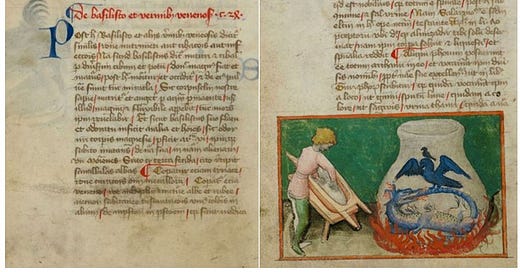The Aurora Consurgens, a luminous 14th-century alchemical treatise shimmering at the threshold of scholastic theology and symbolic mysticism, offers an unexpected path of reconciliation between two seemingly divergent spiritual visions: Western Thomism and Eastern Sophiology. In its pages, one hears both the clarity of divine intellect and the song of divine beauty—a rising dawn in which Uncreated Wisdom and Created Wisdom meet.
Though attributed in some manuscripts to St. Thomas Aquinas (1225–1274)—the preeminent Dominican theologian of the Latin Church and architect of the Summa Theologiae—the Aurora Consurgens departs from his typical scholastic rigor. Instead, it reads as a dreamlike hymn of longing, structured with metaphysical precision yet saturated with biblical poetry and alchemical imagery. In its voice, we hear a Thomas not disputing, but burning.
It is not impossible to imagine that this Aurora, this rising light, was written in the final silence of Aquinas’s life—when, after his mystical experience before the crucifix at Naples, he famously said of his writings: “All that I have written seems like straw compared to what I have seen.” Scholars often read this as a mystical renunciation; but might it also have been a transfiguration? A sign that Thomas, the great synthesizer of Aristotle and Scripture, had glimpsed the fire behind reason—and was beginning to speak, if only briefly, in the tongue of Sophia? If so, Aurora Consurgens could be read not just as a poetic fragment, but as Thomas’s late and luminous turn toward a higher mode of vision — a Sophia-lit radiance beyond dialectic.
At the heart of Thomism stands Christ the Logos, the eternal Sapientia (Wisdom) of the Father. In Aquinas’s metaphysical vision, Wisdom is not a metaphor but a real, uncreated attribute of God, identical with the Second Person of the Trinity. It is through this Logos that all things are made, and through whom the divine ideas—those eternal patterns of creation—reside in the divine intellect. This Sapientia Major, as we might call it, is rational, ordered, and luminous in being.
In contrast, Sophiology, most fully articulated in modern times by Russian thinkers like Vladimir Solovyov (1853–1900) and Sergei Bulgakov (1871–1944), centers on Sophia, the Divine Wisdom who appears in Scripture not only as an attribute but as a radiant, speaking presence. In Proverbs, Ecclesiasticus, and the Book of Wisdom, she is portrayed as both co-creator and immanent guide. For the Sophiologists, Sophia is not a fourth hypostasis (although there have been accusations of such positing), but rather the glory of God revealed in creaturely form—a mediating presence between God and creation. Often mystically identified with the Blessed Virgin Mary, Sophia is the feminine transparency of divine light, shimmering through all that is beautiful, ordered, and redeemed.
The Aurora Consurgens allows us to envision a framework in which these two traditions—scholastic and symbolic, metaphysical and mystical—do not clash but converge. Here, Wisdom speaks in the first person—not as a distinct divine Person, but as a theological icon of the Logos expressing itself within the soul, within matter, and within the bride. The text bridges Aquinas’s metaphysical realism with Sophiology’s bridal cosmology, treating Wisdom as both principle and presence, intellect and flame, order and desire.
In this synthesis, Christ remains Sapientia Major—the eternal Word and Light of the Father. Sophia is Sapientia Minor — not divine in essence, but the highest created likeness of divine Wisdom, apprehending Divinity Itself, the consubstantiality of the Trinity, the shared Light or “unifying face” of God, refracted most especially in Mary, the Church, and redeemed creation. Aquinas would describe such a likeness as a participation in divine being. Sophiology, meanwhile, sings of that participation with symbolic radiance, naming it not an idea but a presence.
Thus, Sophia is not to be understood as an autonomous figure beside the Trinity, but as the cosmic, feminine imprint of the Logos — the light of Christ in the mode of beauty and receptivity. Thomism fashions a Holy Grail of Being that Sophiology fills with the sweet Waters of Pulchritūdō Dei. Where the Dominican reasons his way to holy tears, the Russian mystic weeps in the sanctification of semiotics. Yet both adore the same Fire.
The Aurora invites us to see that the Bride in the Song of Songs is not only the Church, but the soul awakened, the cosmos longing, the Wisdom of God returning in love. It reveals that the Scholastic eye and the mystical heart can gaze upon the same divine furnace — and call it Wisdom.
In the crucible of the Aurora, we discover that Truth becomes Beauty when set aflame, and Beauty becomes Truth when returned to its fiery source. Thomism builds the heavenly altar; Sophiology anoints it with heaps of myrrh. Both kneel before the same Dawn streaming downward.
Afterward: Prayer to Sapientia Duplex
O Eternal Wisdom,
begotten Light of the Father,
in whom the stars were measured
and the Word was sung before time—
You are the fire that knows itself,
the Logos made flesh,
the cruciform pattern of all being.
O Created Wisdom,
mirror of that light,
garment of glory,
virginal womb and radiant earth—
You are the dance upon the waters,
the silence that receives,
the rose in whom the dew of heaven rests.
Christ our Truth,
Mary our Mirror,
unite in us the twin flames of knowing and beholding.
Let our intellect burn with clarity,
and our hearts bow in brightness.
Make of our souls a vessel
where the Sun may descend
and the Bride may say Yes.
Amen.



